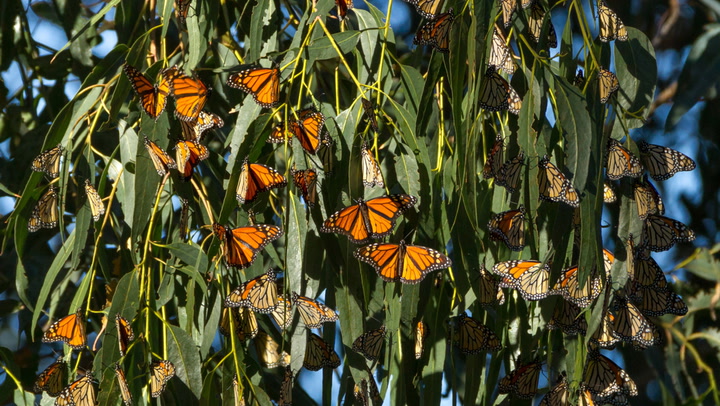Just as the air begins to cool and the days become that much shorter, the iconic monarch butterflies make their arrival along the California coast.
By the thousands, these tiny creatures bat their vibrant orange and black wings in unison, finding refuge from the cold for their long winter break. Interestingly, they choose many of the same destinations for their winter migration as we do for our vacations.
This fall and winter may be critical for witnessing the butterflies and contributing to their protection for future generations.
Where the Butterflies Come From
According to the California Department of Parks and Recreation, there are two distinct populations of monarch butterflies in the U.S.—those living east of the Rockies and those to the west. While eastern monarchs typically migrate to Mexico for the winter, the western population migrates to the central and southern California coast.
“Migration is not an uncommon phenomenon,” the department explains. “In October, as colder weather approaches, the butterflies instinctively know they must fly south to escape freezing temperatures. Some must fly over 1,000 miles. The journey is hazardous, and many never make it. By November, most seek shelter in trees stretching from the San Francisco Bay Area south to San Diego.”
Where They Land
As noted by the department, the butterfly’s landing range is extensive; however, one specific location stands out: Pismo State Beach.
“[It] hosts one of the largest overwintering congregations, varying in numbers from 20,000 to 200,000,” the department stated. The monarchs reside there for another six to eight months. On warmer days, they venture from their trees to find food and water before migrating north again around February.
Why Pismo? Because it features an abundance of eucalyptus trees, which the butterflies favor for their winter habitat. For the 2021/22 season, visitors can enjoy the Pismo State Beach Monarch Butterfly Grove, which is open to the public for day use. The park also opens its Docent Trailer from 10 a.m. to 4 p.m., allowing visitors to ask questions, with daily talks scheduled at 11 a.m. and 2 p.m.
Nearby accommodations include the Vespera Resort, a delightful seaside hotel perfect for enjoying the outdoors, and the Inn at the Pier, a contemporary boutique inn that prides itself on personalized service. Additionally, numerous Airbnbs are available, including a charming bohemian bungalow close to the butterfly grove.
Why Now Is the Time to See Them
While you may spot a handful of butterflies today, just a few years ago, they were seen by the millions.
“Once, millions of monarchs overwintered along the Pacific coast in California and Baja, Mexico—an estimated 4.5 million in the 1980s. However, by the mid-2010s, the population had declined by about 97%,” the Xerces Society for Invertebrate Conservation explains. “Starting in 2018, monarch butterflies faced difficult seasons in their migratory and breeding grounds in the western states. In the following two winters, the annual Xerces Western Monarch Thanksgiving Count recorded a new low: In both 2018 and 2019, volunteers counted under 30,000, less than 1% of the population’s historic size. In 2020, that number dropped to less than 0.01%, with volunteers counting under 2,000 monarchs.”
Numerous factors are harming the population. Scientists described this situation as “a death by a thousand cuts,” including loss of habitat, global warming, and increased herbicide and pesticide use, which adversely affects milkweed, the exclusive food source for monarch caterpillars.
In 2020, Xerces conducted a study sampling 227 milkweed leaves from 19 sites across the Central Valley of California. It found 64 pesticides (25 insecticides, 27 fungicides, and 11 herbicides, alongside one adjuvant) in the plants. The study indicated that pesticides were detected in every sample, even at sites with minimal pesticide use.
“It’s challenging to pinpoint the single most impactful factor,” said Claire Pavelka, a biologist with the non-profit River Partners. “Monarchs serve as a canary in a coal mine… They are well studied and consistent indicators of broader ecological health. Their rapid decline likely signifies that many other pollinators, as well as bees and other butterflies, are also struggling.”
How You Can Help
Despite the dire situation, scientists emphasize that it’s still possible to save this beautiful species, with multiple ways to contribute to their conservation.
The Monarch Joint Venture, dedicated to conserving butterfly migration, has shared several helpful tips:
- Create a pollinator habitat by planting native milkweed and nectar plants in your garden.
- Report sightings and observations to community science projects like the Western Monarch Milkweed Mapper, Journey North, and Monarch Larva Monitoring Project.
- Spread awareness about the decline of monarchs and conservation opportunities by sharing articles and studies.
- Support organizations focused on protecting western monarchs, such as the Monarch Joint Venture, through donations or volunteering efforts.
Furthermore, you can support the Center for Biological Diversity, which advocates for adding the monarch butterfly to the endangered species list, urging Congress to significantly increase funding for conservation efforts.
“There were once so many butterflies that the sound of their wings was likened to a rippling stream or summer rain,” the center noted. “Early newspaper accounts described branches breaking under the weight of countless butterflies, portraying these masses as ‘the personification of happiness.'” Now, it’s up to us to restore that beauty.





